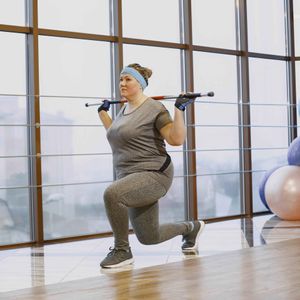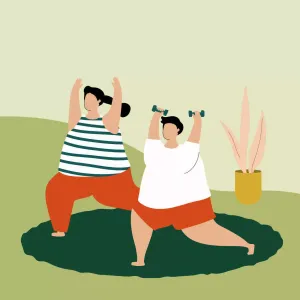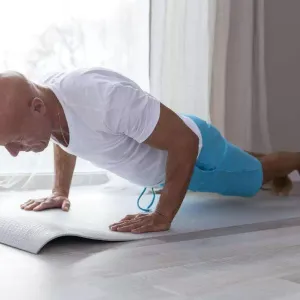

Our Review Process
Our articles undergo extensive medical review by board-certified practitioners to confirm that all factual inferences with respect to medical conditions, symptoms, treatments, and protocols are legitimate, canonical, and adhere to current guidelines and the latest discoveries. Read more.
Our Editorial Team
Shifa Fatima, MSc.
Author
Dr. Apoorva T, MHM.
MEDICAL ADVISOR
Before You Start Walking For Exercise
Walking was essentially the sole mode of transportation available to mankind in ancient history. Getting from one location to another required us to use our own two feet, but fortunately, our bodies are built for walking. With the passage of time, we discovered new means of transportation that allowed us to go a little bit more swiftly, such as Segways, vehicles, and horses. And now that a new era of technology has dawned, the majority of people now look for the closest parking place to the grocery store entrance to save themselves a long walk inside! An excellent strategy to strengthen and maintain your overall health is to go for a walk. An improvement in cardiovascular fitness, bone strength, decreased body fat, and increase in muscular strength and endurance may all be achieved with just 30 minutes of exercise every day. Additionally, it can lower your chance of contracting illnesses including heart disease, type 2 diabetes, osteoporosis, and several malignancies. Walking is a cost-free fitness option that doesn't need any specialized gear or prior experience. Your health can be improved by engaging in physical activity even if it is not strenuous or prolonged. According to a 2007 study of sedentary women, even a modest amount of exercise—roughly 75 minutes per week—improved their fitness levels considerably when compared to a control group that did not exercise.
Walking is a low-impact exercise that requires no gear, could be practiced at any time of the day and has the freedom for doing at your own pace. You don't have to be concerned about the hazards involved with certain more strenuous types of exercise when you go for a stroll. The elderly, overweight, and those who haven't worked out in a while can all benefit from walking as a form of physical activity. Listed below are some benefits of walking for seniors:
1. Better Cardiovascular Health:
This is only one of the numerous benefits of walking for seniors. Finding physical exercise that older citizens would adhere to is a challenge for healthcare personnel. However, given that it can be done by men and women of all ages, walking is a very well-adapted physical activity for sedentary people like the elderly. Additionally, it carries a low risk of injury. Numerous advantages to heart health are offered by walking for seniors and a regular increase in heart rate lowers the risk of coronary heart disease, excessive blood pressure, and even high cholesterol. Even a daily 30-minute stroll can enhance circulation, which thereby benefits senior citizens' overall cardiovascular health.
2. Improved Immunity:
The elderly can grow a physique with solid foundations and get active by walking alone. According to a Harvard study involving more than 12,000 people, those who walked briskly for roughly an hour each day were much less likely to be affected by 32 common genes that promote obesity. Additionally, research shows that those who walk frequently have a lower risk of illness than those who never exercise. The immune system might deteriorate with age, but walking is one of the best strategies to maintain a strong immune system that will provide you with a stronger defense against common ailments. The benefits of walking for seniors are many and this is one of the most important of them.
3. Low Participation Cost:
Low participation cost is one of the terrific advantages of walking that makes it easier to use the benefits of walking for seniors. Once you've spent money on a pair of decent, durable shoes, you can practically walk anywhere—for free! The best thing about walking is that it doesn't cost you any money, in contrast to gym memberships and coaching sessions, which may be pricey for certain people to invest in. Workout gear and gym memberships can be expensive expenditures, but if you don't utilize them frequently, they are a waste of money. As individuals age, money becomes more of a concern, making pricey machinery investments not always feasible. Fortunately, all you need for walking is a good pair of shoes and some perseverance. One of the most affordable forms of exercise is walking, which many individuals can include in their daily routines because it frequently doesn't seem like an exercise in spite of it having many wonderful advantages. In a nutshell, it is the most cost-effective form of exercise you can undertake to enhance your health.
4. Boosts Mental Health:
Long, consistent walks can be exceptionally beneficial for mental health! They can aid in reducing tension, anxiety, and even depressive symptoms. Walking is a cardiovascular workout that is believed to release endorphins, which are feel-good hormones that help you feel happy. In addition to enhancing cognition and lowering the risk of cognitive decline and dementia, maintaining an active lifestyle can also increase focus, memory, processing speed, and cognitive function. The fact that walking can be done in groups is another fantastic aspect of it! This is a terrific method to interact with others, spend time with loved ones, or perhaps meet some new individuals making it one of the most important benefits of walking for seniors.
5. Promotes Social Engagement:
One of the major benefits of walking for seniors is that it helps them be outside and socialize with other people which can have a beneficial impact, much to how endorphins from exercise will improve emotions. Every day, you may socialize with different people and take pleasure in your surroundings. Going for a stroll increases your chances of meeting new people, whether it be by joining a walking group in your community or simply striking up a conversation with a neighbor as you pass by. Regardless, studies have consistently shown the significant advantages of maintaining social connections for seniors' mental and physical health.
Table of Contents
What You Will Need For Walking
Now that we understand the infinite benefits of walking for seniors, it is equally important to understand what gear one needs for walking. When you decide to start walking more, sometimes it isn't ideal to just put your sneakers on and head out. more so if it's something you haven't done in a while. So, when you're prepared to begin walking, you must first ask yourself: Do I have everything I need?" Walking is a fantastic exercise since it requires very little equipment. But if you gather what you need, you'll be able to walk comfortably and possibly avoid being hurt. The following are five crucial items you should consider bringing with you if you feel like going for a stroll.
1. Sunscreen
Walking outside with the sun on your face and the breeze at your back is a magical experience. However, over time, those components can have a disastrous effect on your skin. Whatever outdoor activity you choose to engage in, don't forget the sunscreen. Skin cancers like melanoma have been on the rise on a yearly basis. Walking without sunscreen is similar to walking barefoot. They both offer a vital defense. Don't scrimp on the application; choose a sunscreen with a high SPF to match the length of your walking workout. Select UVA and UVB rays-protecting products with a broad range. The ideal SPF range is between 30 and 50.
2. Hats
For most climates, walking with hats with bills is ideal. The best approach to prevent the elements from interfering with your walks is to wear a hat. The visor will keep rainwater from splashing into your face if you find yourself walking in the rain. But more often than not, the component you need to be most concerned with is on the other side of the spectrum. It's never enjoyable to run while the sun is in your eyes. It may even be extremely harmful. For people who spend an excessive amount of time directly in the sun's UV rays, photokeratitis is a very serious concern. In light of this, wearing the correct UV 400 protection is crucial if you run outside frequently. Although sunglasses are helpful for this, you'll be considerably safer if your face is covered by the brim of a hat.
3. Walking Shoes And Socks
Purchase a premium pair of sporting shoes as an investment in your feet. Walking in stiff boat shoes or worn-out, non-supportive sneakers is a recipe for discomfort. Do your feet a favor and look for a shop in your neighborhood that sells shoes for experienced runners. Good socks are necessary for addition to the appropriate footwear. Cotton traps moisture close to your skin, which raises the possibility of developing blisters. Wearing socks made of sweat-wicking material will assist your feet to remain fresh and comfortable. To ensure a proper fit, put your walking shoes on with socks as well, especially if you want thicker socks.
4. Pack
Instead of holding something in your hands, it is advisable to wear a fanny pack or backpack to equalize the burden on your hips. If all you need is your water bottle and a few other essentials, a fanny pack can be worn. An excellent alternative to a water bottle is a cell phone carrier. Try a lightweight string backpack with more supportive straps for increased load capacity. Using a modest hydration pack allows you to drink while walking for walks longer than an hour.
5. Water
Walking is an aerobic exercise, and it causes you to sweat off the water. A large bottle of water should be consumed at least an hour before your stroll to get you started. Then, as you go, sip water as needed. You should either bring water with you or arrange your route so you can easily visit a water fountain every 20 to 30 minutes if you want to be able to complete the walk comfortably. It is best to refrain from holding water in your hands since it might be cumbersome and cause shoulder and wrist pain.
Set Relevant Goals For Yourself
One of the simpler and cheaper activities to start with, there are lots of benefits of walking for seniors, but it still takes the same consideration and preparation as any other new fitness regimen. Setting suitable and attainable objectives requires an understanding of your body, its capabilities, and its limits. Setting impossible standards for yourself will make it difficult for you to achieve them, which will make you give up on your entire fitness regimen. Setting exercise objectives is crucial since everybody is unique and requires a customized program. Listed below are a few pointers to keep in mind before starting your walking regimen.
1. Ease Into It
Even though walking is recognized as low-impact activity, we don't suggest that you jump right in. If it has been some time since you last took a stroll, avoid doing too much, too quickly, and refrain from doing what you used to do. The important thing is to ease into an activity, regardless of how intense it is. If it has been quite a while since your last walk, start by covering half of the distance you previously covered and work your way back up to where you were. Allow your body enough time to recover, and gradually increase the distance and magnitude you exercise each week. Preparation is an additional consideration. Warming up appropriately is the key to maximizing your walking workouts and preventing injury. It's a good idea to light warm up even when walking. This will assist you to prepare for the activity by easing your muscles and joints.
2. Listen To Your Body
Pay attention to the signals your body sends you. Your talents are subject to daily alteration.
It can be best to take a break if you're feeling unwell or your muscles are too sore to continue. Before beginning any new workout regimen, it is always important to speak with your doctor or physiotherapist. Those who want to maintain their health can benefit much from walking, but it's crucial not to push yourself too hard or go too quickly. Remember that every little bit counts. Don't stress about swiftly walking three miles, at least not at first. A stroll around the block can be helpful. Help yourself climb the ladder and constantly maintain good health.
3. Map Out Your Intentions
You must have a purpose for starting a fitness regimen, and identifying that motive is the very first step. Your ability to achieve your objective will increase with its clarity. Aiming high is commendable, but you also need to be careful not to lose motivation while working for it. Make sure you have a sincere desire to do this. You might not be as effective at losing weight if you're only trying to do it because you feel like you should as you would be if you were motivated by a specific goal. Setting a deadline for your fitness goal might help motivate you to continually work hard since some tension can be beneficial.
How To Add Walking To A Daily Routine
It may be difficult to juggle obligations, relationships, and work while also trying to get adequate rest, eat well, and keep active. Walking is the ideal, low-impact activity that can easily fit into your schedule, whether you've had a healthy lifestyle for many years or are just looking to jump-start your fitness objectives. We know it may be particularly difficult to find time to exercise. Now that we are aware of the significance of walking and how helpful it can be to seniors' physical and mental health, let's examine how to include walking in everyday life without feeling overly taxed.
1. Find a walking buddy!
Engaging in a chat while walking adds a little more intensity to the workout, which makes it a terrific social activity. Making plans to go for a stroll with a buddy offers encouragement because most individuals won't want to disappoint a friend. Organizing a lunchtime stroll with coworkers gets the group outside and in the fresh air. Additionally, it's a fantastic chance to expand your network and become motivated.
2. Make It Convenient
Being prepared for a stroll shouldn't need much forethought. Simply carry a pair of walking shoes in your automobile or shopping bag so that they are close at hand for when you find a few minutes to go for a stroll. Don't worry too much about locating the ideal walking track; if you just have a short amount of time, you can use it to walk around the neighborhood. Avoid complicating the situation when considering how to incorporate walking into your daily schedule.
3. Walk More, Park Less
Your regular chores or activities can be found close to one another on foot. Find a parking spot in the center of everything, then go on foot to the pharmacy, grocery shop, and dry cleaners. If you commute to work every day, park the car as far away from your property as possible in the parking lot and start your stroll there. Plan to park further away from your location than normal if you find yourselves in a car. When you need to be outside anyhow, this is a wonderful way to get some walking in.
4. Multitask
Add something to your stroll to keep it from becoming monotonous. Take a break by listening to audiobooks or music, or partake in a charity walk. Another option is to make a list of tasks you want to complete along the journey, such as clearing up trash, gathering pebbles and shells, or visiting nearby historical places. Whatever be the task, multitasking is the key!

How Many Steps Should Seniors Take Each Day?
You are not required to walk for thirty minutes on your very first day if you are an elderly person. Set a reasonable time limit at the outset and pause when you need to relax. Ten minutes a day is a fantastic place to start. Choose a tempo that feels secure and comfortable as you gradually increase your step count. Keep an eye on your sensations as you walk, especially if you are dealing with a particular health issue. If you experience any discomfort stop and take a break. Look for a comfortable location to sit down if you start to feel faint or lightheaded. When you're prepared, go home and make a doctor's appointment. Consume plenty of water to maintain your hydration.
There is no issue if you walk with a cane or walker. You may use them to improve your balance and reduce impact and joint discomfort. If your doctor gives the all-clear, you may need to adjust your speed and distance, but don't allow a cane or walker to prevent you from obtaining your recommended amount of steps. The 7,000–10,000 steps per day for the elderly are advised by several professionals. People who have a disability or a chronic condition can still potentially benefit from an exercise routine and should aim for 5,500 steps per day, depending on their particular capabilities. Many elderly people fall within the 6,500–8,500 step range.
Tools To Track Your Walking
Whether you've just begun your walking program or are an experienced walker, specific gadgets can improve the efficacy of your stroll and make walking more convenient for you. Although you just need your feet and supportive gear to walk, adding accessories to your walking routine can be beneficial in a number of ways. Listed below are a number of popular tools to track your walking.
- Smartphone Tracking
- Activity Trackers
- Pedometers
- Smart Watches
Tips For Walking With Arthritic/Painful Knees
People with arthritis are advised to walk since it is low-impact, keeps the joints flexible, promotes bone health, and lowers the chance of osteoporosis. If you do have discomfort or are really stiff later, consider exercising a little less, taking extra time to relax, and consulting your doctor as necessary. Making walking a regular part of your routine can help you with arthritis by conditioning the muscles around your joints and assisting you in maintaining a healthy weight. Walking might be difficult with sensitive knees, but it is advised to keep your function and lessen your discomfort. You don't have to allow knee discomfort from osteoarthritis or other reasons to prevent you from beginning a walking program. Listed below are a few tips for walking with osteoarthritis or sensitive knees.
Tip one:
Start off slowly. The first week, you can exercise for five minutes every day; the following week, you can extend your exercise for a few extra minutes.
Tip two:
Change your regimen as necessary. Be mindful of your body and how you feel. Since joint discomfort might change from day to day, it's crucial to adjust your walking distance and duration according to how you are feeling that particular day.
Tip three:
Always warm up. To warm up, begin by gently moving your joints. Before engaging in aerobic activity, you could start with five to ten minutes of range-of-motion exercises. And when you finally begin to walk, concentrate on making each step lightly.
Tip four:
Stretch regularly. You should continue to be active even if your RA or OA pain flares up. Simple stretches might help to lessen some of the discomforts.
Tip five:
Pick softer surfaces for walking. It's gentler on the joints to walk on pathways with an organic surface.
Disclaimer
This website's content is provided only for educational reasons and is not meant to be a replacement for professional medical advice. Due to individual differences, the reader should contact their physician to decide whether the material is applicable to their case.








